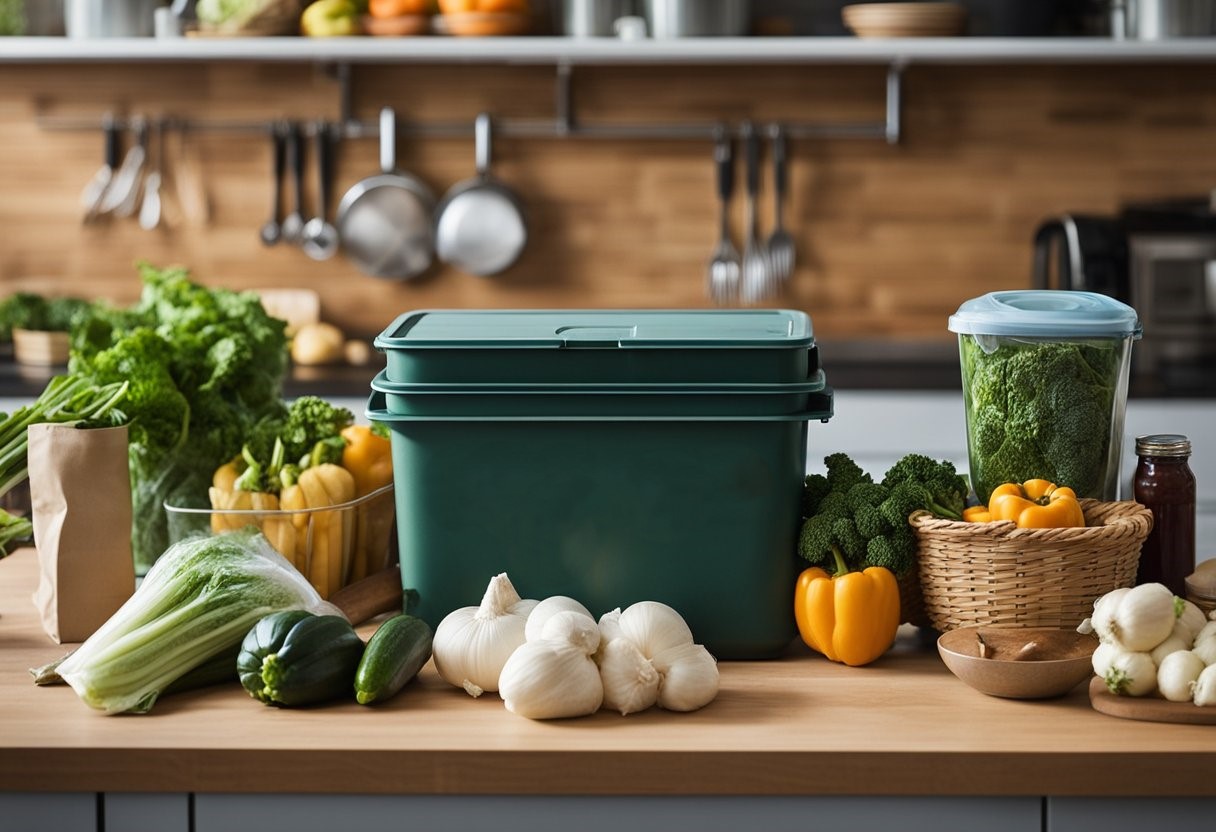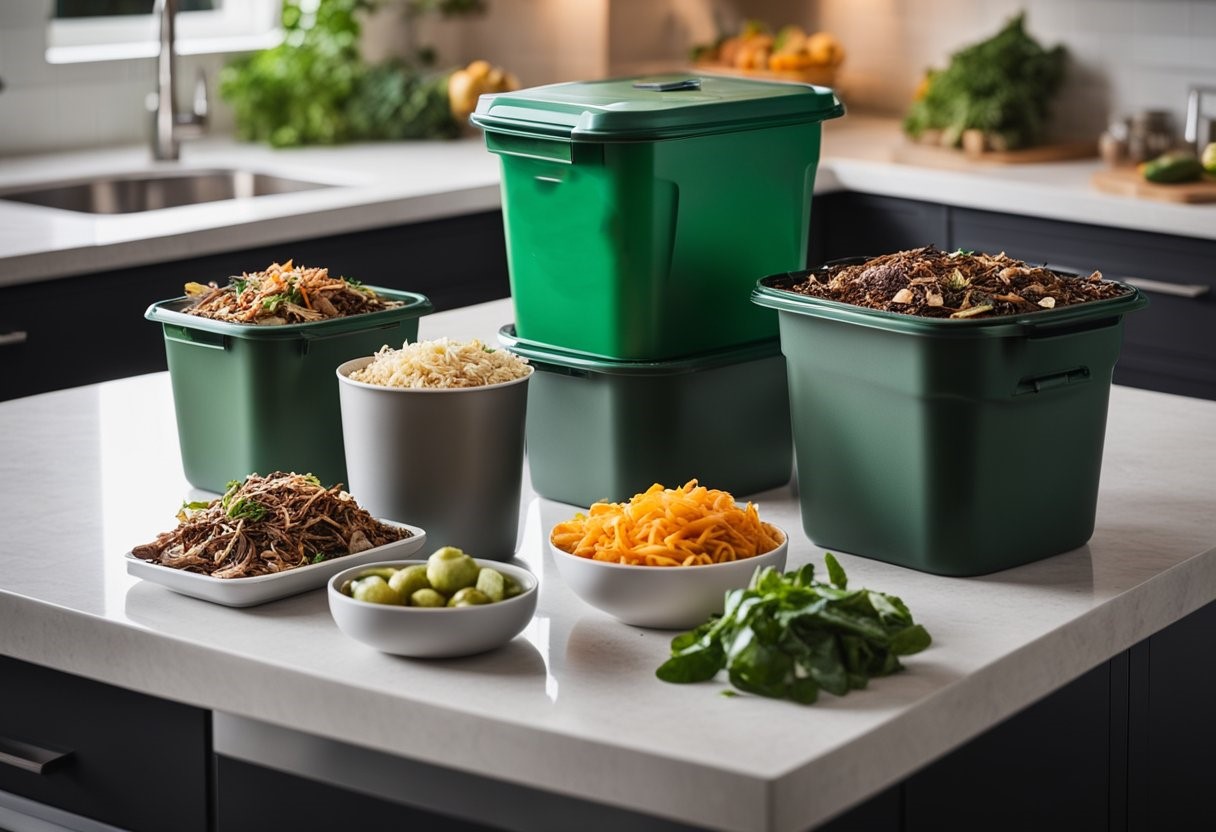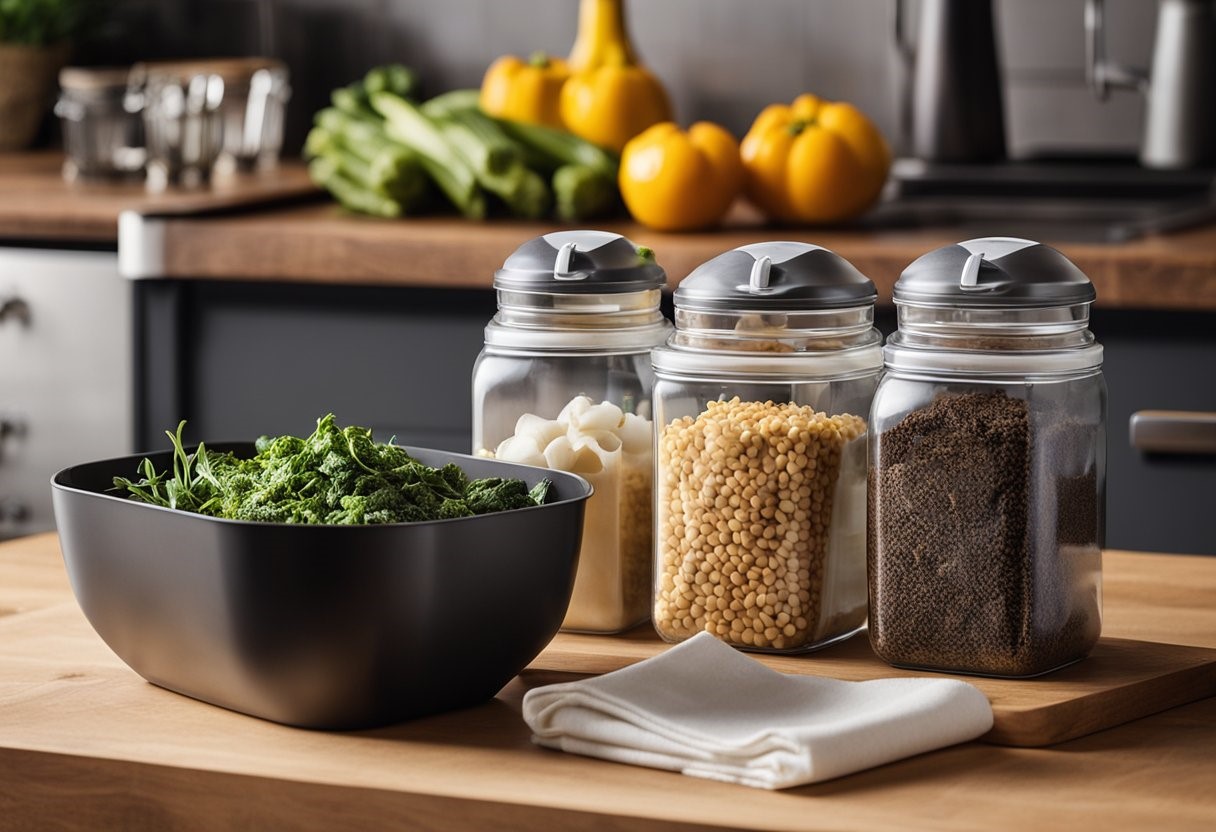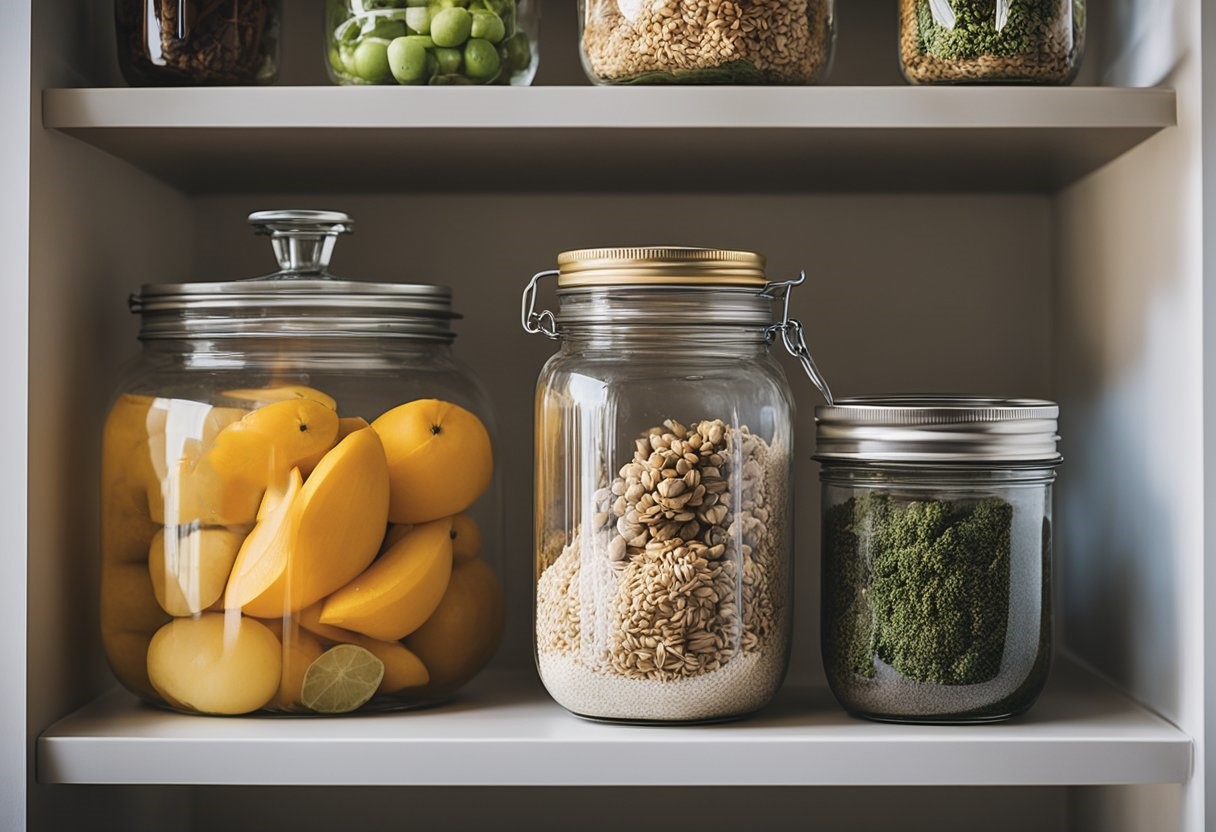A zero waste kitchen is a space where all waste is minimized or eliminated. It is a sustainable and eco-friendly way of living that is gaining popularity among people who are concerned about the environment. The goal of a zero waste kitchen is to reduce the amount of waste that goes to landfills by reusing, recycling, and composting as much as possible.

Understanding Zero Waste in the Kitchen is the first step towards creating a zero waste kitchen. It involves analyzing the waste generated in the kitchen and finding ways to reduce it. This can be achieved by identifying the sources of waste, such as food scraps, packaging, and cleaning products, and finding alternatives that are sustainable and eco-friendly.
Setting up your zero waste kitchen is the next step towards achieving a zero waste lifestyle. This involves investing in reusable containers, jars, and bags for storing food and buying in bulk to reduce packaging waste. It also involves choosing eco-friendly cleaning products and investing in composting systems to manage food waste. By taking these steps, you can create a sustainable and eco-friendly kitchen that is free from waste.
Key Takeaways
- Understanding Zero Waste in the Kitchen is the first step towards creating a sustainable and eco-friendly kitchen.
- Setting up a Zero Waste Kitchen involves investing in reusable containers, jars, and bags, buying in bulk, and choosing eco-friendly cleaning products.
- By creating a Zero Waste Kitchen, you can reduce waste and contribute to a healthier environment.
Table of Contents
Table of Contents
Understanding Zero Waste in the Kitchen
Principles of Zero Waste
A zero waste kitchen is a kitchen that aims to reduce its environmental impact by generating as little waste as possible. The principles of zero waste are based on the 5 R’s: Refuse, Reduce, Reuse, Recycle, and Rot. These principles can guide individuals in their journey to creating a no-waste kitchen when they have any doubts or need to make any accommodations or swaps based on their needs.
Refusing to use single-use items is the first step towards zero waste. It means saying no to plastic bags, straws, and other disposable items that are used for a short period and then thrown away. Reducing waste is the second principle and involves using less of everything, from food to packaging. Reusing items is the third principle and involves using items multiple times before discarding them. Recycling is the fourth principle and involves diverting waste from landfills by recycling materials like paper, plastic, and glass. Rotting is the final principle and involves composting organic waste.
Benefits of a Zero Waste Kitchen
A zero waste kitchen has many benefits. First and foremost, it reduces the amount of waste that ends up in landfills, which helps reduce greenhouse gas emissions. By reducing the amount of waste produced, individuals can also reduce their carbon footprint. A zero waste kitchen can also save money by reducing the need to purchase single-use items and by using food scraps to create new meals. Finally, a zero waste kitchen promotes sustainability by reducing the consumption of resources and by encouraging individuals to be more mindful of their impact on the environment.
Creating a zero waste kitchen is a simple and effective way to reduce one’s environmental impact and promote sustainability. By following the principles of zero waste, individuals can reduce their carbon footprint, save money, and help protect the planet for future generations.
Setting Up Your Zero Waste Kitchen
When it comes to setting up a zero waste kitchen, there are a few key things to keep in mind. First and foremost, it’s important to focus on reusables. This means investing in items that can be used over and over again, rather than disposable products that will end up in the landfill.
Essential Reusables
One of the most important things you can do when setting up a zero waste kitchen is to invest in reusable containers. Glass jars are a great option for storing dry goods like beans, grains, and pasta. They’re durable, easy to clean, and can be used over and over again. Stainless steel containers are also a good choice, particularly for storing liquids like soup and broth.
Reusable bags are another essential item for a zero waste kitchen. These can be used for everything from grocery shopping to storing produce in the fridge. Look for bags made from sustainable materials like cotton or hemp, and be sure to wash them regularly to keep them clean and hygienic.
Cloth napkins are another great addition to a zero waste kitchen. They’re more sustainable than paper napkins, and can be washed and reused again and again. Plus, they come in a variety of colors and patterns, so you can choose ones that match your decor.
Choosing Sustainable Materials
When it comes to choosing materials for your zero waste kitchen, it’s important to focus on sustainability. Beeswax wraps are a great alternative to plastic wrap, as they can be used over and over again and are biodegradable at the end of their life. Look for wraps made from organic cotton and beeswax, and avoid ones that contain synthetic materials.
In addition to beeswax wraps, there are a variety of other sustainable materials you can choose for your kitchen. Bamboo utensils are a great alternative to plastic, as they’re durable, easy to clean, and biodegradable. You can also find cutting boards made from sustainable materials like bamboo or reclaimed wood.
By focusing on reusables and sustainable materials, you can set up a zero waste kitchen that is both functional and environmentally friendly.
Sustainable Shopping and Storage
Shopping with Less Waste
One of the easiest ways to reduce waste in the kitchen is to shop with less packaging. This can be achieved by buying in bulk, shopping at farmers markets, and joining local co-ops. When shopping in bulk, bring your own reusable containers such as glass jars or Tupperware. This not only reduces waste but also saves money in the long run as buying in bulk is often cheaper.
Farmers markets are a great way to buy fresh, locally grown produce which usually comes with less packaging. By supporting local farmers, you are also reducing the carbon footprint associated with long-distance transportation. Local co-ops are another great option as they often sell products in bulk and use minimal packaging.
Storing Food Sustainably
Storing food sustainably is just as important as shopping with less waste. Invest in glass containers or Tupperware to store leftovers instead of using single-use plastic bags or cling wrap. This not only reduces waste but also keeps food fresh for longer. When storing produce, use reusable produce bags instead of plastic ones. This not only reduces waste but also helps to keep produce fresh for longer. For meat lovers, check out how to freeze meat without plastic.
By shopping with less waste and storing food sustainably, individuals can significantly reduce their environmental footprint. These small changes can make a big difference in the long run and contribute to a more sustainable future.
Waste-Free Cooking and Meal Planning

Zero Waste Recipes
Cooking waste-free meals is an essential step in reducing kitchen waste. By using ingredients that are in season and locally sourced, you can minimize the amount of waste generated during the cooking process. You can also try to incorporate more plant-based meals into your diet, which can be both healthy and environmentally friendly.
To further reduce waste, consider using all parts of the ingredients you’re cooking with. For example, use the stems of broccoli or kale in soups or stir-fries, or use carrot tops in pesto. Get creative with your cooking and try new recipes that use up ingredients that might otherwise go to waste.
Meal Prepping Strategies
Meal planning and prepping can also help reduce waste in the kitchen. By planning out meals ahead of time, you can purchase only the ingredients you need and avoid overbuying. This can help reduce food waste and save you money in the long run.
When prepping meals, consider using reusable containers rather than disposable ones. Glass containers or stainless steel containers are great options as they are durable and can be used repeatedly. Make sure to label your containers with the date and contents to avoid confusion and prevent food from going bad.
Another way to reduce waste is to repurpose leftovers. For example, leftover roasted vegetables can be turned into a salad or used as a filling for a wrap. Leftover grains can be used in soups or stir-fries. By getting creative with your leftovers, you can reduce waste and save money.
Composting and Managing Food Waste

Composting Basics
Composting is a simple and effective way to reduce food waste and create nutrient-rich soil for your garden. It involves collecting vegetable scraps, fruit peels, and other organic matter and allowing it to decompose naturally. This process creates a rich soil amendment that can be used to fertilize plants and improve soil health.
To get started with composting, you’ll need a compost bin. There are many different types of compost bins available, including plastic bins, wire mesh bins, and wooden bins. Choose a bin that suits your needs and budget, and make sure it has good ventilation and drainage.
Once you have your compost bin, start collecting vegetable scraps, fruit peels, and other organic matter. Avoid adding meat, dairy, and oily foods, as they can attract pests and slow down the composting process. You can also add yard waste, such as leaves and grass clippings, to your compost bin.
To speed up the composting process, turn your compost pile regularly and keep it moist. You can also add compost activators, such as manure or compost tea, to help break down the organic matter more quickly.
Reducing Food Waste
Composting is just one way to reduce food waste in the kitchen. Here are some other tips to help you minimize food waste:
- Plan meals ahead of time to avoid overbuying and wasting food.
- Store food properly to extend its shelf life. For example, keep vegetables in the crisper drawer of your refrigerator, store dry goods in airtight containers, and freeze meat without plastic.
- Use up leftovers by incorporating them into new meals or freezing them for later.
- Donate excess food to a local food bank or compost it if possible.
Eco-Friendly Cleaning Practices

Keeping a zero waste kitchen clean can be challenging, but there are a few eco-friendly cleaning practices that can help. Here are some tips and tricks for keeping your kitchen clean while reducing waste.
Natural Cleaning Products
Many commercial cleaning products contain harsh chemicals that are harmful to the environment. Instead, consider using natural cleaning products, such as vinegar and baking soda. Vinegar is a natural disinfectant and can be used to clean countertops, sinks, and floors. Baking soda is a great alternative to abrasive cleaners and can be used to clean ovens and stovetops. Both vinegar and baking soda can be purchased in bulk, reducing the need for single-use plastic containers.
Reducing Paper and Plastic Use
Paper towels and single-use plastic cleaning products can quickly add up and contribute to waste. Instead, consider using reusable cleaning cloths and sponges. These can be washed and used multiple times, reducing the need for single-use products. Additionally, consider using cloth napkins instead of paper towels for cleaning up spills and messes. This can help reduce the amount of paper waste generated in the kitchen.
Mindful Consumption and Lifestyle

Reducing waste in the kitchen starts with mindful consumption and lifestyle choices. By assessing needs versus wants, individuals can make more informed purchasing decisions and reduce their overall consumption. Supporting sustainable brands and choosing secondhand options are also effective ways to promote a sustainable future.
Assessing Needs vs. Wants
Before making a purchase, it is essential to assess whether the item is a need or a want. By prioritizing needs and reducing the number of wants, individuals can reduce their overall consumption and waste. One way to assess needs versus wants is to ask yourself whether the item is necessary for daily life or if it is a luxury item that can be lived without. Additionally, you can consider the lifespan of the item and whether it will be used for an extended period or if it will quickly become obsolete.
Supporting Sustainable Brands
Another way to promote a sustainable future is to support sustainable brands. Sustainable brands prioritize environmentally friendly practices and materials, reducing waste and promoting a circular economy. By choosing sustainable brands, individuals can ensure that their purchases align with their values and contribute to a sustainable future. Some sustainable brands offer products made from recycled materials or use renewable energy sources in their production processes.
It is also important to note that supporting sustainable brands may come at a higher cost. However, individuals can consider the long-term benefits of investing in high-quality, sustainable products that will last longer and reduce waste in the long run.
Engaging in the Zero Waste Community

Engaging in the zero-waste community can be a great way to learn more about sustainable living and to connect with like-minded individuals. Here are some ways to get involved:
Learning from Others
One way to learn more about zero-waste living is to attend local events and meetups. These events can include workshops, talks, and other activities that focus on sustainable living. Attending these events can be a great way to learn from others who are already living a zero-waste lifestyle.
Another way to learn from others is to join online communities, such as my blog, and forums dedicated to zero-waste living. These communities can provide a wealth of information and support, as well as a platform to ask questions and share ideas.
Sharing Your Journey
Sharing your own zero-waste journey can also be a great way to engage with the community. By sharing your experiences and tips, you can inspire others to make changes in their own lives.
One way to share your journey is to spread the word (and my blog) on social media. This can be a great way to connect with others and to share your experiences and ideas.
Another way to share your journey is to get involved in local initiatives, such as community gardens, local farmers markets, and co-ops. These initiatives can provide a platform to share your knowledge and to connect with others who are interested in sustainable living.
Engaging in the zero-waste community can be a great way to learn more about sustainable living and to connect with others who share your values.
Frequently Asked Questions

How can I start transitioning to a zero waste kitchen?
Transitioning to a zero waste kitchen can seem overwhelming at first, but it is achievable with small steps. Start by assessing your current waste habits and identifying areas where you can make changes. Consider buying in bulk, using reusable containers, and composting food scraps. You can also research recipes that use whole ingredients to reduce packaging waste.
What are essential items for a zero waste kitchen?
Essential items for a zero waste kitchen include reusable containers, bags, and jars for food storage, reusable water bottles, and cloth napkins. It is also helpful to have a compost bin and a set of reusable utensils. Consider investing in quality cookware and appliances that are durable and energy-efficient to reduce waste.
What are some cost-effective strategies for maintaining a zero waste kitchen?
Maintaining a zero waste kitchen can be cost-effective with some simple strategies. Buy in bulk to reduce packaging waste and save money. Use cloth napkins instead of disposable ones and wash them with your regular laundry. Repurpose glass jars and containers for food storage instead of buying new ones. Consider making your own cleaning products with simple ingredients like vinegar and baking soda.
How does zero-waste cooking differ from traditional cooking methods?
Zero-waste cooking focuses on using whole ingredients and reducing food waste. It involves planning meals to use up ingredients before they go bad and using all parts of fruits and vegetables, including peels and stems. Zero-waste cooking also involves composting food scraps and using them to enrich soil for future gardening.
What are the benefits of a zero waste kitchen for the environment?
A zero waste kitchen can have significant benefits for the environment. By reducing waste, you are reducing the amount of materials that end up in landfills, reducing greenhouse gas emissions, and conserving natural resources. Zero waste kitchens also promote mindful consumption and can inspire others to make sustainable choices.
Can you recommend any comprehensive guides or books for creating a zero waste kitchen?
There are many resources available for creating a zero waste kitchen. Some popular books include “Zero Waste Home” by Bea Johnson and “Waste Not: How To Get The Most From Your Food” by James Beard Foundation. Online resources like blogs (www.sustainablehands.com) and social media accounts can also provide inspiration and tips for reducing waste in the kitchen.

I’m Chris, a passionate advocate for sustainability, sharing my journey and tips from our vibrant family farm. With a background rooted in zero-waste living and a heart committed to eco-friendly practices, I aim to empower others through my blog. Each post is a blend of personal experiences or a question I have once pondered, and practical advice for those looking to make sustainable choices in their daily lives. Join me in making every step a greener one, as we explore the joys and challenges of living sustainably together.
Pingback: Sustainability Education: Why It’s Essential for a Greener Future - Modern Day School House